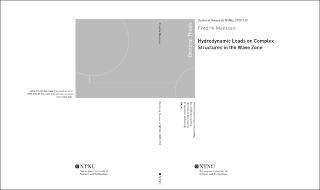| dc.description.abstract | The hydrodynamic loads on simplified structures relevant for deployment of subsea modules are studied in a two-dimensional setting. Experimental investigations and numerical simulations are performed. In the experiments, models are fixed in incident waves or forced to oscillate. Numerical simulations are conducted for models fixed in incident waves, oscillating flow and orbital flow. The simulations are performed using implemented potential flow and viscous flow (Navier–Stokes) solvers. Good agreement between the experimental and numerical results is, in general, found.
The main focus is on perforated platelike structures. The hydrodynamic added mass and damping coefficients are obtained in experiments and simulations of forced oscillations. The importance of the damping force is discussed; the hydrodynamic force of ideal perforated plates is dominated by damping if the perforation ratio, _, is larger than 10 %. In general, the coefficients increase with increasing Keulegan–Carpenter (KC) number and decreasing perforation ratio. An exception is if the perforation ratio is equal to or smaller than 20 %, in which case the damping of perforated plates can be larger than that of a corresponding solid plate for small KC numbers. The largest KC number where this is observed is KC = 1.25 (_ = 5 %). The coefficients depend on the structural details of the plate, but are relatively insensitive to the number of perforations or holes. However, for very small KC numbers, i.e., KC ! 0, the number of holes, not the perforation ratio, is the important parameter for the added mass coefficient of the structure.
The importance of flow-separation from the plate-ends of perforated plates is highlighted. Comparisons are made between numerical simulations where the flow is allowed to separate everywhere on the plates, and simulations using a hybrid numerical scheme where the flow is allowed to separate through the perforations of the plate only, not at the plate-ends. The importance of the global plate-end flow separation increases considerably with increasing KC number and decreasing perforation ratio, however, it is important even for KC numbers smaller than KC = 0.5.
The characteristics of the force on perforated structures fixed in incident waves depend on the distance from the mean free-surface to the structure. Nonlinear free-surface effects are important if the structure can go in and out of water, in particular a large slamming peak occurs, due to water entry of the structure into the incident wave. Contrary, if the model is fully submerged, the force characteristics share strong similarities with the force characteristics of forced orbital or oscillating flows in infinite fluid domains. The normalized force amplitude of fully submerged perforated plates in incident waves increases, in general, with increasing KC number, increasing wavelength and increasing distance to the mean free-surface. The force on fully submerged models in incident waves is similar to the force on models in oscillating flow for small KC numbers, but considerably smaller for large KC numbers.
The hydrodynamic loads of single and parallel perforated plates in orbital flow are similar to that of oscillating flow for small KC numbers, and smaller than in oscillating flow for large KC numbers. Contrary to the near symmetric plateend vortices which are found in oscillating flow, the plate-end flow separation is asymmetric in orbital flow. This reduces the force in orbital compared to oscillating flow, and is a likely reason why the force is smaller on fully submerged perforated plates in incident waves than in oscillating flow.
In oscillating flow, the hydrodynamic loads on a structure consisting of two perforated plates with five relatively large bodies in between, are completely dominated by the loads on the perforated plates. For two parallel perforated plates in oscillating flow, interaction effects reduce the total force on the configuration compared to superposition of two single plates. The force is reduced on both plates, in particular the instantaneously downstream plate. The added mass of parallel perforated plates is similar to superposition of two corresponding single plates, however, the damping is considerably reduced.
Based on present results, simple expressions for the force on perforated plates are presented. The expressions are inspired by the hydrodynamic load model for solid plates, analytically derived by Graham. The present method yields the added mass and damping coefficients of ideal perforated plates in oscillating flow as functions of the perforation ratio and the KC number. | en_US |
